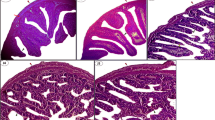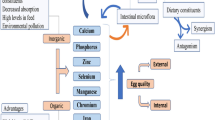Abstract
Selenoprotein W (SelW) and selenium (Se) plays important roles in gastrointestinal function and that SelW expression in the gastrointestinal system of mammals is sensitive to Se levels. However, little is known about the pattern of SelW expression in the bird gastrointestinal tract. To investigate the distribution of SelW and effects of dietary Se levels on the SelW mRNA expression in the gastrointestinal tract tissues of birds, 1-day-old male chickens were fed either a commercial diet or a Se-supplemented diet containing 1.0, 2.0, 3.0 or 5.0 mg/kg sodium selenite for 90 days. The gastrointestinal tract tissues (tongue, esophagus, crop, proventriculus, gizzard, duodenum, small intestine, cecum and rectum) were collected and examined for Se content and mRNA levels of SelW. The mRNA expression of SelW was detected in all tissues. The greatest increase in SelW mRNA levels was observed in the gizzard, whereas Se content was highest in the duodenum and small intestine. A significant increase in SelW mRNA levels was observed in the gastrointestinal tract tissues of chickens fed the diets containing 1–3 mg/kg sodium selenite while decreased SelW mRNA levels were observed in the esophagus, crop, proventriculus, gizzard, duodenum and cecum in chickens fed the diet containing 5 mg/kg sodium selenite. These data indicate that SelW is widely expressed in the gastrointestinal tract tissues of birds and the transcription of the SelW gene is very sensitive to dietary Se.



Similar content being viewed by others
References
Aachmann FL, Fomenko DE, Soragni A, Gladyshev VN, Dikiy A (2007) Solution structure of selenoprotein W and NMR analysis of its interaction with 14-3-3 proteins. J Biol Chem 282(51):37036–37044
Beilstein MA, Vendeland SC, Barofsky E, Jensen ON, Whanger PD (1996) Selenoprotein W of rat muscle binds glutathione and an unknown small molecular weight moiety. J Inorg Biochem 61(2):117–124
Bellingham J, Gregory-Evans K, Fox MF, Gregory-Evans CY (2003) Gene structure and tissue expression of human selenoprotein W, SEPW1, and identification of a retroprocessed pseudogene, SEPW1P. Biochim Biophys Acta 1627(2–3):140–146
Berry MJ (2005) Insights into the hierarchy of selenium incorporation. Nat Genet 37(11):1162–1163
Brown KM, Arthur JR (2001) Selenium, selenoproteins and human health: a review. Public Health Nutr 4(2B):593–599
Castellano S, Lobanov AV, Chapple C, Novoselov SV, Albrecht M, Hua D et al (2005) Diversity and functional plasticity of eukaryotic selenoproteins: identification and characterization of the SelJ family. Proc Natl Acad Sci USA 102(45):16188–16193
Chariot P, Bignani O (2003) Skeletal muscle disorders associated with selenium deficiency in humans. Muscle Nerve 27(6):662–668
Combs GF Jr (2005) Current evidence and research needs to support a health claim for selenium and cancer prevention. J Nutr 135(2):343–347
Combs GF Jr, Clark LC, Turnbull BW (2001) An analysis of cancer prevention by selenium. Biofactors 14(1–4):153–159
Gu QP, Beilstein MA, Barofsky E, Ream W, Whanger PD (1999) Purification, characterization, and glutathione binding to selenoprotein W from monkey muscle. Arch Biochem Biophys 361(1):25–33
Gu QP, Sun Y, Ream LW, Whanger PD (2000) Selenoprotein W accumulates primarily in primate skeletal muscle, heart, brain and tongue. Mol Cell Biochem 204(1–2):49–56
Gu QP, Ream W, Whanger PD (2002) Selenoprotein W gene regulation by selenium in L8 cells. Biometals 15(4):411–420
Hasunuma R, Ogawa T, Kawanishi Y (1982) Fluorometric determination of selenium in nanogram amounts in biological materials using 2,3-diaminonaphthalene. Anal Biochem 126(2):242–245
Hoffmann PR, Berry MJ (2008) The influence of selenium on immune responses. Mol Nutr Food Res 52(11):1273–1280
Hoffmann PR, Hoge SC, Li PA, Hoffmann FW, Hashimoto AC, Berry MJ (2007) The selenoproteome exhibits widely varying, tissue-specific dependence on selenoprotein P for selenium supply. Nucleic Acids Res 35(12):3963–3973
Jeong D, Kim TS, Chung YW, Lee BJ, Kim IY (2002) Selenoprotein W is a glutathione-dependent antioxidant in vivo. FEBS Lett 517(1–3):225–228
Kaur P, Bansal MP (2005) Effect of selenium-induced oxidative stress on the cell kinetics in testis and reproductive ability of male mice. Nutrition 21(3):351–357
Kryukov GV, Gladyshev VN (2004) The prokaryotic selenoproteome. EMBO Rep 5(5):538–543
Kryukov GV, Castellano S, Novoselov SV, Lobanov AV, Zehtab O, Guigo R et al (2003) Characterization of mammalian selenoproteomes. Science 300(5624):1439–1443
Li JL, Gao R, Li S, Wang JT, Tang ZX, Xu SW (2010) Testicular toxicity induced by dietary cadmium in cocks and ameliorative effect by selenium. Biometals 23(4):695–705
Lu J, Holmgren A (2009) Selenoproteins. J Biol Chem 284(2):723–727
Mahmoud KZ, Edens FW (2005) Influence of organic selenium on hsp70 response of heat-stressed and enteropathogenic Escherichia coli-challenged broiler chickens (Gallus gallus). Comp Biochem Physiol C 141(1):69–75
Martin-Romero FJ, Kryukov GV, Lobanov AV, Carlson BA, Lee BJ, Gladyshev VN et al (2001) Selenium metabolism in Drosophila: selenoproteins, selenoprotein mRNA expression, fertility, and mortality. J Biol Chem 276(32):29798–29804
Moriarty PM, Reddy CC, Maquat LE (1998) Selenium deficiency reduces the abundance of mRNA for Se-dependent glutathione peroxidase 1 by a UGA-dependent mechanism likely to be nonsense codon-mediated decay of cytoplasmic mRNA. Mol Cell Biol 18(5):2932–2939
Pagmantidis V, Bermano G, Villette S, Broom I, Arthur J, Hesketh J (2005) Effects of Se-depletion on glutathione peroxidase and selenoprotein W gene expression in the colon. FEBS Lett 579(3):792–796
Papp LV, Lu J, Holmgren A, Khanna KK (2007) From selenium to selenoproteins: synthesis, identity, and their role in human health. Antioxid Redox Signal 9(7):775–806
Peirson SN, Butler JN, Foster RG (2003) Experimental validation of novel and conventional approaches to quantitative real-time PCR data analysis. Nucleic Acids Res 31(14):e73
Pfaffl MW (2001) A new mathematical model for relative quantification in real-time RT-PCR. Nucleic Acids Res 29(9):e45
Rayman MP (2000) The importance of selenium to human health. Lancet 356(9225):233–241
Reeves MA, Hoffmann PR (2009) The human selenoproteome: recent insights into functions and regulation. Cell Mol Life Sci 66(15):2457–2478
Schweizer U, Schomburg L, Savaskan NE (2004) The neurobiology of selenium: lessons from transgenic mice. J Nutr 134(4):707–710
Stadtman TC (2000) Selenium biochemistry. Mammalian selenoenzymes. Ann N Y Acad Sci 899:399–402
Sun Y, Ha PC, Butler JA, Qu BR, Yeh JY, Whanger PD (1998) Effect of dietary selenium on selenoprotein W and glutathione peroxidase in 28 tissues of the rat. J Nutr Biochem 9:23–27
Sun Y, Butler J, Forsberg N, Whanger PD (1999) Selenoprotein W, selenium and glutathione peroxidase in rat and sheep brains and in brain cell cultures. Nutr Neurosci 2:227–237
Sunde RA, Raines AM, Barnes KM, Evenson JK (2009) Selenium status highly regulates selenoprotein mRNA levels for only a subset of the selenoproteins in the selenoproteome. Biosci Rep 29(5):329–338
Terry EN, Michal JJ, Hostetler CE, Kincaid RL, Johnson KA (2009) Levels of mRNA for three selenoproteins in skeletal muscle of fetal and newborn pigs. Livest Sci 124:21–25
Vendeland SC, Beilstein MA, Yeh JY, Ream W, Whanger PD (1995) Rat skeletal muscle selenoprotein W: cDNA clone and mRNA modulation by dietary selenium. Proc Natl Acad Sci USA 92(19):8749–8753
Wang XL, Yang CP, Xu K, Qin OJ (2010) Selenoprotein W depletion in vitro might indicate that its main function is not as an antioxidative enzyme. Biochemistry 75(2):201–207
Whanger PD (2000) Selenoprotein W: a review. Cell Mol Life Sci 57(13–14):1846–1852
Yeh JY, Beilstein MA, Andrews JS, Whanger PD (1995) Tissue distribution and influence of selenium status on levels of selenoprotein W. FASEB J 9(5):392–396
Yeh JY, Gu QP, Beilstein MA, Forsberg NE, Whanger PD (1997a) Selenium influences tissue levels of selenoprotein W in sheep. J Nutr 127(3):394–402
Yeh JY, Vendeland SC, Gu Q, Butler JA, Ou BR, Whanger PD (1997b) Dietary selenium increases selenoprotein W levels in rat tissues. J Nutr 127(11):2165–2172
Yeh JY, Ou BR, Gu QP, Whanger PD (1998) Influence of gender on selenoprotein W, glutathione peroxidase and selenium in tissues of rats. Comp Biochem Physiol B 119(1):151–155
Zhang Y, Fomenko DE, Gladyshev VN (2005) The microbial selenoproteome of the Sargasso Sea. Genome Biol 6(4):R37
Zhou JC, Zhao H, Li JG, Xia XJ, Wang KN, Zhang YJ et al (2009) Selenoprotein gene expression in thyroid and pituitary of young pigs is not affected by dietary selenium deficiency or excess. J Nutr 139(6):1061–1066
Acknowledgment
This study was supported by the National Natural Science Foundation of China (30871902).
Author information
Authors and Affiliations
Corresponding authors
Additional information
Jin-Long Li and Hui-Xin Li contributed equally to this work.
Rights and permissions
About this article
Cite this article
Li, JL., Li, HX., Li, S. et al. Selenoprotein W gene expression in the gastrointestinal tract of chicken is affected by dietary selenium. Biometals 24, 291–299 (2011). https://doi.org/10.1007/s10534-010-9395-0
Received:
Accepted:
Published:
Issue Date:
DOI: https://doi.org/10.1007/s10534-010-9395-0




